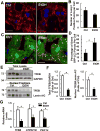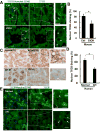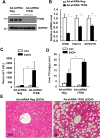Impaired TFEB-Mediated Lysosome Biogenesis and Autophagy Promote Chronic Ethanol-Induced Liver Injury and Steatosis in Mice
- PMID: 29782848
- PMCID: PMC6120772
- DOI: 10.1053/j.gastro.2018.05.027
Impaired TFEB-Mediated Lysosome Biogenesis and Autophagy Promote Chronic Ethanol-Induced Liver Injury and Steatosis in Mice
Abstract
Background & aims: Defects in lysosome function and autophagy contribute to the pathogenesis of alcoholic liver disease. We investigated the mechanisms by which alcohol consumption affects these processes by evaluating the functions of transcription factor EB (TFEB), which regulates lysosomal biogenesis.
Methods: We performed studies with GFP-LC3 mice, mice with liver-specific deletion of TFEB, mice with disruption of the transcription factor E3 gene (TFE3-knockout mice), mice with disruption of the Tefb and Tfe3 genes (TFEB and TFE3 double-knockout mice), and Tfebflox/flox albumin cre-negative mice (controls). TFEB was overexpressed from adenoviral vectors or knocked down with small interfering RNAs in mouse livers. Mice were placed on diets of regular ethanol feeding plus an acute binge to induce liver damage (ethanol diet); some mice also were given injections of torin-1, an inhibitor of the kinase activity of the mechanistic target of rapamycin (mTOR). Liver tissues were collected and analyzed by immunohistochemistry, immunoblots, and quantitative real-time polymerase chain reaction to monitor lysosome biogenesis. We analyzed levels of TFEB in liver tissues from patients with alcoholic hepatitis and from healthy donors (controls) by immunohistochemistry.
Results: Liver tissues from mice on the ethanol diet had lower levels of total and nuclear TFEB compared with control mice, and hepatocytes had decreased lysosome biogenesis and autophagy. Hepatocytes from mice on the ethanol diet had increased translocation of mTOR into lysosomes, resulting in increased mTOR activation. Administration of torin-1 increased liver levels of TFEB and decreased steatosis and liver injury induced by ethanol. Mice that overexpressed TFEB in the liver developed less severe ethanol-induced liver injury and had increased lysosomal biogenesis and mitochondrial bioenergetics compared with mice carrying a control vector. Mice with knockdown of TFEB and TFEB-TFE3 double-knockout mice developed more severe liver injury in response to the ethanol diet than control mice. Liver tissues from patients with alcohol-induced hepatitis had lower nuclear levels of TFEB than control tissues.
Conclusions: We found that ethanol feeding plus an acute binge decreased hepatic expression of TFEB, which is required for lysosomal biogenesis and autophagy. Strategies to block mTOR activity or increase levels of TFEB might be developed to protect the liver from ethanol-induced damage.
Keywords: Fatty Liver; Gene Regulation; Hepatic Protection; Mouse Model.
Copyright © 2018 AGA Institute. Published by Elsevier Inc. All rights reserved.
Conflict of interest statement
Figures







Comment in
-
Insufficient autophagy: a novel autophagic flux scenario uncovered by impaired liver TFEB-mediated lysosomal biogenesis from chronic alcohol-drinking mice.Autophagy. 2018;14(9):1646-1648. doi: 10.1080/15548627.2018.1489170. Epub 2018 Jul 29. Autophagy. 2018. PMID: 29969942 Free PMC article.
-
TFEB, a master regulator of lysosome biogenesis and autophagy, is a new player in alcoholic liver disease.Dig Med Res. 2018 Sep;1:16. doi: 10.21037/dmr.2018.09.03. Epub 2018 Sep 26. Dig Med Res. 2018. PMID: 30450489 Free PMC article. No abstract available.
References
Publication types
MeSH terms
Substances
Grants and funding
LinkOut - more resources
Full Text Sources
Other Literature Sources
Research Materials
Miscellaneous

